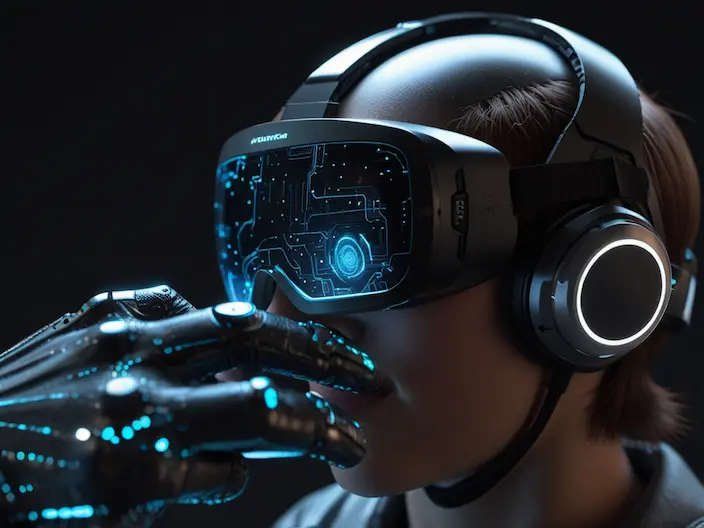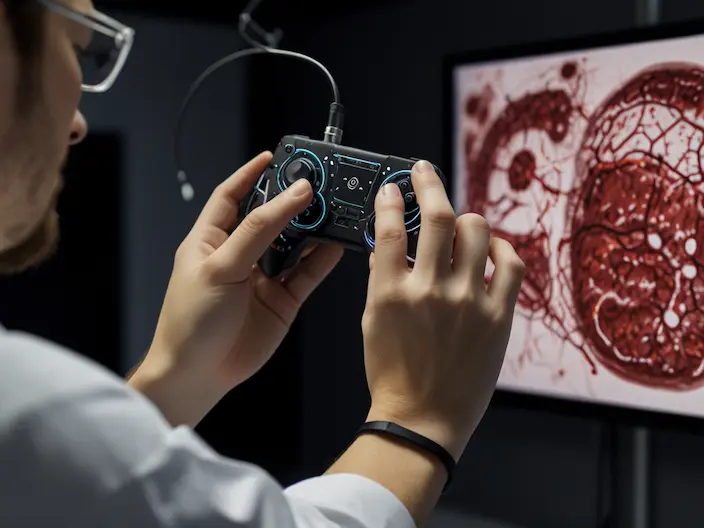- Introduction
- What is Haptic Technology?
- Types of Haptic Technology
- Types of Haptic Sensors
- Applications of Haptic Sensors
- Advantages of Haptic Sensors
- Haptic Sensors, The Beating Heart of Interactive Technologies
- Types of Haptic Devices in the Metaverse
- Key Components of Haptic Systems
- How Haptic Sensors Work
- Scientific and Practical Benefits of Using Haptic Devices in the Metaverse
- Advanced Applications of Haptic Sensors in the Metaverse
- Challenges and the Future of Haptic Technology
- Future Developments in Haptic Technology
- Conclusion
Introduction
The Metaverse, as an immersive virtual world, holds the potential to deliver unparalleled experiences that blur the boundaries between the real and virtual worlds. One of the key elements for achieving this goal is creating tactile sensations and physical interaction with the virtual environment. Haptic technology, by providing tactile and vibrational feedback, plays a pivotal role in immersing users in the Metaverse.
This article explores the role of haptic technology in creating realistic sensory experiences and advanced interactions in the Metaverse. This technology not only enhances the quality of sensory experiences but also opens new pathways for research and development in cognitive sciences, physiology, and human-machine interaction system design.
What is Haptic Technology?
Haptic technology refers to a set of techniques and devices that allow users to physically interact with the virtual world and objects through touch. By providing sensations such as touch, pressure, vibration, and even temperature, it takes user experience to an entirely new level, making virtual reality feel more real. Common examples include haptic gloves, sensory suits, and vibration controllers.

Types of Haptic Technology
- Active Haptics
In this type, the device actively applies a force to the user. For instance, when touching a virtual object, the device creates resistance to simulate the sensation of touching a real object.
- Passive Haptics
Instead of applying force, the device responds to user movements. For example, haptic gloves that simulate touch by adjusting to finger movements.
Types of Haptic Sensors
Haptic sensors are categorized based on their operational mechanisms:
- Multi-Point and Multi-Touch Sensors
- Multi-Point Sensors
Detect multiple points of contact simultaneously, essential for devices like tablets and smartphones.
- Multi-Touch Sensors
Beyond detecting contact points, these sensors recognize multi-finger gestures, enabling complex actions like zooming, rotation, and navigation.
- Resistive Sensors
The simplest type, consisting of two conductive layers that change resistance upon pressure. While affordable, they are sensitive to dust and excessive force.
- Capacitive Sensors
Operate based on changes in electrical capacitance. They offer higher accuracy and sensitivity, are dust-resistant, and are widely used in smartphones and tablets.
- Optical Sensors
Use light to detect touch, offering high accuracy and quick response, often found in professional-grade displays.
- Surface Acoustic Wave Sensors
Use sound waves to measure changes during touch, enabling high precision and multi-touch detection.
- Pressure and Force Sensors
- Pressure Sensors
Measure the force applied, commonly used in digital design tools.

- Force Sensors
Detect minor force changes, offering highly accurate and natural tactile experiences.
- Thermal Sensors
Detect temperature changes, simulating sensations of warmth or coldness, such as the heat of a flame or the chill of ice.
- Ultrasonic Sensors
Use sound waves to measure distances, enabling the creation of three-dimensional tactile surfaces.
- Structured Optical Sensors
Provide detailed information about the position and shape of the contacted object using optical patterns.

Applications of Haptic Sensors
- Touch Displays
Smartphones, tablets, laptops, and touchscreens
- Touch Keyboards
Virtual keyboards and touchpads
- Remote Controls
Television and audio system remotes
- Automotive
Control panels and information displays
- Industry
Control panels for industrial machinery and automation systems
- Healthcare
Diagnostic devices and surgical equipment
Advantages of Haptic Sensors
- Ease of Use
Direct interaction without additional tools
- Portability
Usable in a wide range of portable devices
- High Precision
Accurate detection of touch position and pressure
- Fast Response Time
Quick operation without delays
- Modern Aesthetics
Sleek and simple designs

Haptic Sensors, The Beating Heart of Interactive Technologies
Haptic sensors are key elements in human interaction with electronic devices. By detecting physical contact, they enable direct control of devices, acting as a bridge between the physical and digital worlds. They play a significant role in creating realistic experiences in the Metaverse by detecting touch, pressure, and motion, allowing for natural and intuitive interaction.
- Types of Haptic Devices in the Metaverse
- Haptic Gloves
These gloves use sensors to detect hand and finger movements, converting them into digital signals for tactile interaction in the virtual environment.
- Sensory Suits
Equipped with sensors and actuators, these suits simulate sensations such as pressure, temperature, and vibration, allowing users to feel the virtual world physically.
- VR Headsets with Hand Tracking
In addition to displaying 3D visuals, these headsets track hand movements, enabling direct interaction with virtual objects.
- Haptic Platforms
Large surfaces where users can interact using their hands or specialized tools, used in industrial design, education, and entertainment.
- Haptic Controllers
Similar to game joysticks but with haptic technology to detect motion and pressure, offering precise and natural control in virtual environments.

- Main Components of Haptic Systems
- Sensors
For detecting user inputs such as movement, pressure, and more.
- Actuators
To generate haptic feedback, such as vibrations, pressure, or temperature.
- Controllers
To process sensor data and control the actuators.
- Software
For developing user interfaces and coordinating various system components.
- Functionality of Touch Sensors
The functionality of touch sensors typically involves a conductive object, such as a human finger, contacting the sensor surface, causing a change in a physical parameter like resistance, capacitance, or light intensity. This change is detected by the sensor’s electronic circuit and converted into an electrical signal for processing by the device.
Haptic technology interacts with the human sensory nervous system using mechanical or electronic actuators to simulate feedback that the brain interprets as real touch. This process relies on several key components, including actuating units like motors or electroactive polymers that produce vibration, pressure, or temperature changes. Advanced processing systems then convert digital signals into physical feedback that users can perceive.
Haptic systems are designed as interactive frameworks that send sensory feedback to the virtual environment and receive environmental responses. Concepts like tactile vibration, force feedback simulation, and texture simulation algorithms enhance realism.
- Scientific and Practical Benefits of Haptic Devices in the Metaverse
One major challenge of the metaverse is replicating human interactions in a completely virtual environment. Haptic technology enables users to not only see and hear the environment but also to feel it through the sense of touch.

- Increased Realism
By adding the sense of touch, users can naturally interact with virtual objects, enhancing the perception of being in the environment.
- Enhanced Immersion
Haptic feedback helps users feel more physically present in the virtual world.
- Advanced Haptic Technologies
- Smart Polymers
Materials that alter their physical properties in response to electrical or magnetic fields are being developed to simulate various sensations such as softness, hardness, or temperature.
- Nanotechnology in Haptic Systems
Nano-scale sensors provide highly detailed and accurate touch feedback, useful for simulating complex textures and small pressure or vibration changes.
- Natural and Complex Interactions
Users can intuitively pick up, press, drag, and interact with virtual objects. Integrating haptic technology with VR and AR can create multisensory stimulation, enhancing cognitive processes like attention, memory, and spatial perception.
- Deeper Learning Experiences
Strengthening memory and understanding through sensory experiences.
- Wide Applications
Haptic technology is useful in video games, education, medicine, product design, and commerce.
- Advanced Social Experiences
In the metaverse, haptic technology enhances social interactions, such as realistic handshakes or hugs.
- Improved Accessibility
Allowing people with disabilities to engage with the virtual world.

- Advanced Applications of Touch Sensors in the Metaverse
- Haptic Gloves
Enable tactile feedback for video games, medical simulators, and interactive training. For instance, users can touch balls in sports games, pick up objects in adventure games, or experience realistic driving sensations in simulations. Vibrational feedback during impacts or pulling a bowstring enhances user immersion.
- Thermal Feedback
Simulating temperature as a vital tactile element allows users to experience realistic environments. Devices like thermoelectric films are being developed for such feedback.
- Haptic Suits
Provide full-body tactile feedback for deeper immersion.
- Virtual Workspaces
Allow users to interact with virtual objects through touch.
- Medical Equipment
Haptic technology is valuable for creating smart prosthetics and rehabilitation systems (e.g., stress relief or patient recovery using VR-based therapies). Prosthetics equipped with haptic feedback enable users to perceive objects naturally.
- Self-Driving Cars
Incorporate haptic interfaces for vehicle control.
- Education
Simulate training environments, such as scientific labs or technical workshops, to create engaging learning experiences. Medical students, for example, can practice surgeries on virtual models with realistic tactile sensations.

- Product Design
Designers can interact with virtual prototypes using haptic feedback to refine designs before production.
- Architecture and Urban Planning
Develop 3D models of buildings and cities.
- E-Commerce
Enable users to feel and assess virtual products, such as touching fabric or testing the weight of an item, before purchase.
- Social Interactions
Simulate physical presence and tactile communication in online interactions with friends and family.
Challenges and the Future of Haptic Technology
- High Cost
Advanced haptic devices remain expensive, which limits their accessibility for average users and hinders widespread adoption.
- Feedback Delay
Generating real-time haptic feedback during user interactions requires powerful hardware and software. Any delay in this process can significantly impact the user experience.
- Standardization
The absence of global standards for haptic technology hampers its rapid and widespread development.

- Security
Protecting biometric data used in haptic technology poses a major challenge.
- Sensitivity to Contaminants
Dust, grease, and moisture can affect the performance of haptic sensors.
- Limited Durability
Over time, the sensitivity of haptic sensors may diminish.
- Production Costs
Manufacturing high-quality, precise sensors can be costly.
- Energy Consumption
Haptic sensors, especially active ones, consume significant amounts of energy.
- Size and Weight
Miniaturizing sensors for portable devices presents a significant challenge.
- Scalability
Designing systems capable of delivering haptic experiences to a large number of users in the metaverse is a considerable challenge.
- Real-Time Interactions
One common issue is creating haptic feedback with near-zero latency to deliver a more realistic experience to users.
- Complexity in Design
Developing haptic systems that can simulate all aspects of the sense of touch remains a significant challenge.

Future Advancements in Haptic Technology
- Artificial Intelligence and Machine Learning
Integrating haptic technology with AI algorithms enables the prediction and personalization of haptic feedback, creating unique user experiences.
- Cloud Technologies
Using cloud computing to manage the vast amount of data associated with haptic feedback enhances accessibility and flexibility.
- Brain-Machine Interfaces (BMI)
Directly connecting haptic technology to the human nervous system through brain-machine interfaces could revolutionize the field.
Despite its challenges, the future of haptic technology is highly promising, potentially becoming an integral part of daily life and transforming our virtual experiences. Rapid advancements in fields such as artificial intelligence, virtual reality, and the Internet of Things are expected to accelerate the development of haptic technology. Future innovations will likely lead to smaller, faster, and more accurate haptic sensors that are also cost-effective, improving feedback precision and reducing latency.
Furthermore, integrating haptic technology with other innovations such as augmented reality and AI could turn the metaverse into an immersive space that fully replicates human sensory experiences.
Conclusion
As a foundational element of the metaverse, haptic technology plays a critical role in creating realistic sensory experiences and enabling advanced interactions, paving the way for groundbreaking transformations in the digital world. While technical and economic challenges persist, cutting-edge advancements promise a future where the metaverse becomes an engaging and fully immersive environment for all human senses.
Table of Contents
Toggle


One Response